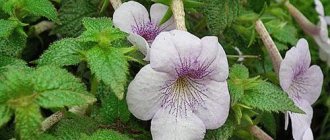- Bear, look: there’s a Christmas tree! Christmas tree!
Many are sure that this shaggy and prickly plant, if not a fern, is definitely a Christmas tree... However, this is not so, and asparagus has nothing to do with ferns or conifers.
Asparagus are herbaceous perennials, woody vines and shrubs with branched, straight, twisting or climbing stems. Many (but not all) of them lack green leaves. Photosynthesis remains the responsibility of flattened branches sitting in the axils of tiny scale-like leaves. In asparagus these branches are usually small, but in butcher's broom they are so large that they can be easily confused with leaves.
Asparagus is a dioecious plant; specimens are also known in which some stems bear male flowers, while others bear female flowers. Along with unisexual flowers, there are also bisexual flowers. Miniature, inconspicuous flowers have the same “device” as lily flowers: six tepals of a simple perianth, six stamens and an upper ovary. A fruit develops from it - a berry with several large seeds. Unlike lilies, asparagus plants do not form bulbs. They are characterized by horizontal rhizomes.
The genus Asparagus today numbers about 300 species, living in South America, Europe, the Mediterranean, India and Australia, mainly in arid areas. You can also find asparagus in our gardens. There it is known as asparagus. Asparagus officinalis is of greatest economic importance. In our apartments we grow only a few types of asparagus.
Asparagus asparagus , or asparagus
. It grows wild in mountain forests and coastal sands of South Africa. The stems are bare, light green, with flexible thin shoots. Phyllocladia (modified stems) are leaf-shaped, ovoid, shiny, bright green. The flowers are small and white. The fruits are orange-red berries. Its one and a half meter creeping shoots sometimes require support. Cut shoots of this asparagus retain their freshness for a long time, so they serve as a good addition when arranging bouquets and flower arrangements. Interestingly, the fruits of this species have an orange scent. This species is very good on a support and as an hanging plant.
Asparagus pinnate
.
It is found as Asparagus bristles
. Homeland: Eastern and Southern Africa; grows in subtropical and tropical forests, river valleys, savannas, plains and in the middle mountain zone. Climbing subshrub. The shoots branch abundantly and are bare. The leaves are reduced to tiny (0.5 cm) triangular brown scales. The modified stems (phyllocladia) resembling thread-like leaves are collected in bunches of 3-12. Their length is 0.5-1.5 cm, diameter - up to 0.5 mm. They are slightly curved, light green, and give an openwork appearance to the entire plant. Individual shoots are oriented horizontally, forming something like finely feathered leaves. The flowers are small, single or 2-4, white. The fruits are berry-shaped, bluish-black, 1-3 seeds. A fairly well-known variety of pinnate asparagus is dwarf asparagus. Perennial unpretentious plant.
Asparagus the finest
very similar to pinnate asparagus, but its phyllocladies are thinner and longer, and are spaced less frequently than those of pinnate. The length of the shoots reaches 1.5 m.
Asparagus Sprenger
.
Synonym: Ethiopian Asparagus
, found as
Asparagus dense-flowered
. Homeland - South Africa, grows on wet mountain slopes. A climbing subshrub, in cultivation a herbaceous perennial plant. Stems are bare, grooved or smooth, abundantly branched, weak, up to 150 cm long. Leaves are reduced to subulate-shaped scales 2-4 mm long. Flattened leaf-like stems - phyllocladies up to 3 cm long, 1-3 mm wide, straight or slightly curved, pointed, single or in bunches of 2-4 cm. The flowers are small white or light pink, fragrant. The fruits are berry-shaped, red, single-seeded. In culture since the end of the 19th century. Loves sunlight and abundant watering in summer.
Asparagus medioloides
is a beautiful tall plant with strongly branching stems and evergreen phyllocladies. Its cut branches remain fresh for a long time even without water.
Meyer's asparagus with densely spaced needles resembles a dish brush; it is less common, but more decorative. Straight and tough, densely pubescent “leaves” shoots reach 40-55 cm in length and effectively set off plants with large leaves in compositions.
Asparagus racemosus
– has long (up to 2 m) shoots; its linear-subulate cladodes are collected in bundles. Fragrant bright pink flowers form a cluster.
Asparagus crescent
- an elegant vine with the longest and thickest shoots among asparagus. In nature, the length of shoots reaches 15 m, and their diameter is up to a centimeter; in a winter garden or greenhouse, the length of the vine is usually up to 4 meters. Flexible stems quickly grow from the rhizome, covered with many sickle-shaped cladodes up to 8 cm long, with corrugated edges. Their color darkens with age. The plant tolerates stem pruning well and forms a lush bush. Spectacular small white flowers with a pleasant scent are collected in a loose inflorescence.
Description of a houseplant and its photo
The genus Asparagus includes about 300 species of perennial plants. Africa is considered its homeland; it grows naturally in India, on the Mediterranean coast of Europe, and in the Far East. The first image of the plant dates back to the 3rd century. BC. Even the ancient Egyptians grew this crop and ate it. After all, the asparagus growing in the apartment belongs to the same genus as vegetable asparagus, only to different species. Ornamental asparagus began to be grown a little over 100 years ago.
Asparagus is prized for its delicate, lush greenery.
The culture is distinguished by its species diversity: it is represented by herbaceous plants, large shrubs or vines. Characteristic features of asparagus are branched shoots, small flowers, berry-shaped fruit, and a powerful tuberous root. Most asparagus do not have green leaves; their role is played by flattened needles located in the axils of small scale-like leaves.
Ornamental asparagus belongs to the same genus as vegetable asparagus
With good care, the flower grows up to 40 cm and lives for more than 10 years.
Asparagus adapt well to living conditions; growing them at home is not at all difficult.
Benefits and harms
Admirers of Indian culture and Feng Shui talk about the amazing properties of this plant. It is believed that it can absorb bad energy and cleanse the aura of negative emotions. In addition, asparagus perfectly cleanses and humidifies the air in the apartment.
ATTENTION: Please note that the berries of the plant are poisonous. Keep the plant away from pets and children!
Asparagus is a supplier of vitamins and nutrients in early spring, when other vegetables are still in short supply. You might be interested in reading articles about Sprenger asparagus, a white and medicinal variety of asparagus.
Types and names: pinnate, Mayer, Sprenger and others
Asparagus pinnately is a branching subshrub with bare shoots. The leaves are small (0.5 cm) triangular scales. Light green phyllocladia slightly curved. The flowers are white. The fruit is a black berry.
Curved light green phyllocladies of asparagus pinnate give an openwork appearance to the entire plant
Asparagus superfine is similar to pinnate, but its phyllocladies are thinner and longer, and are quite sparsely located. The length of the shoots is up to 1.5 m. It blooms with white flowers, the fruits are black.
Mayer's asparagus is a subshrub with straight stems up to 60 cm long, heavily pubescent - this feature is characteristic only of this species. Small phyllocladies grow close to each other.
Asparagus Mayer differs from other species in having highly pubescent stems.
Crescent asparagus is a vine with long thick shoots up to 15 m long. On flexible stems there are numerous sickle-shaped cladodes up to 8 cm long, with corrugated edges. The flowers are white.
Sprenger's asparagus is a herbaceous plant. Stems are bare, branched, up to 1.5 m long. Leaves are in the form of scales 2–4 mm long. Phyllocladia up to 3 cm long, straight or slightly curved. The flowers are white or light pink. The fruits are red berries.
Varieties in the photo
Asparagus officinalis contains many useful elements
Asparagus asparagus is a climbing shrub that blooms with white flowers.
The small flowers of Sprenger asparagus are very fragrant
Asparagus crescent is distinguished by crescent-shaped cladodes
Variety of asparagus on video
Description and characteristics
Asparagus pinnately is a perennial evergreen shrub with climbing thin stems.
The leaves are reduced and appear as small scales. The function of photosynthesis is performed by modified, thin, slightly curved stems (phyllocladia). They are formed in the form of bunches, each of which has up to 12 stems. The flowers are small and white.
The fruits are blue-black berries with seeds inside. Thread-like stems give the plant a decorative, openwork appearance.
In its natural environment, it is distributed in subtropical and tropical forests of Africa.
A few photos with this plant:
Other common types of Asparagus on our website: Sprenger, Crescent, Meyer.
Comfortable growing conditions
| Lighting | Many types of asparagus prefer bright, diffused light, so it is better to place the flower on the western or eastern side, protecting it from direct sunlight, which can burn the greenery. You can also place the flower on the north side, but in low light it becomes less decorative, the shoots become very elongated, and the phyllocladies on them are sparse. In summer, you can take asparagus out to the balcony or terrace, gradually accustoming it to new conditions after winter. Place them in partial shade, protecting them from drafts. |
| Humidity | The plant feels comfortable in a humid microclimate. Dry air can lead to yellowing of leaves and even death of the flower. Therefore, it is necessary to spray asparagus more often. You can leave it in the bathroom overnight after a shower. In winter, the flower should not be kept near heating devices. |
| Temperature | The optimal summer temperature is +20–25 degrees. Does not tolerate extreme heat well. In winter, the room should not be below +12–15°C, otherwise the plant will begin to dry out and shed its leaves. |
| Watering | In spring and summer, regular watering is needed, once every 3-4 days. However, the soil should not be over-watered. In winter, water less often. |
| Feeding | Asparagus is fed weekly in spring and summer, and once a month in winter. At the same time, the soil is enriched, plant growth is enhanced, and their immunity is increased. |
| Transfer | Young plants are replanted every year, adults - once every 2-3 years. |
| Trimming | Shortened shoots no longer grow, but pruning stimulates the growth of new branches. |
| Reproduction | Asparagus is propagated by seeds, cuttings, and division of rhizomes. |
Asparagus prefer bright, indirect light
Do I need to replant pinnate asparagus?
Asparagus pinnate grows very quickly, so annual replanting is required. A pot that is too large may simply burst under the pressure of overgrown roots.
Replanting is also required if you have just purchased your asparagus in the store. For transplantation, choose a more spacious pot compared to the old one. The asparagus is carefully removed from the pot, the soil is shaken off, and the rhizomes can be trimmed a little. All exposed old shoots are removed. If your bush is old enough, it can be replanted every two to three years.
Carefully! Asparagus should not be placed in children's rooms, since its berries, attractive to children, are very poisonous.
Planting and transplanting
Young asparagus are replanted annually, because they grow rapidly and the overgrown roots become cramped in the pots. More mature plants are replanted less frequently, every 2–3 years.
The best time to transplant is spring. The plant tolerates the procedure quite easily and grows quickly. In the fall, only transshipment is carried out.
Important! Until the asparagus roots fill the entire container, the greens will not grow. Therefore, when replanting, select a pot that is only 2–3 cm larger than the previous one.
If the asparagus is not replanted, the roots and tubers, growing, will come to the surface, the flower will begin to experience an acute deficiency of nutrients and moisture, which will negatively affect its appearance. In addition, by carefully examining the plant during transplantation, you can detect diseases in time and take urgent action.
- Before transplanting, pour a ball of earth and take the flower out of the pot.
- Inspect the root system, remove old and dried branches, trim too long or rotten roots, which promotes the growth of young shoots. Carefully separate the nodules.
- Prepare nutritious loose soil.
- Choose a slightly larger pot
- Place drainage on the bottom and sprinkle with earth.
- The roots of the renewed asparagus are placed in a container and covered with new soil, no higher than the previous level.
- After planting, lightly moisten the soil and observe the flower for the first time.
When transplanting, carefully inspect the root system
After transplantation, the asparagus experiences stress and will need some time to get used to the new conditions. If the flower begins to dry out, it should be placed for 5–7 days in a dimly lit place, without watering or fertilizing. Then gradually move on to the correct content.
Transplant rules - video
The newly purchased plant also needs to be replanted in new soil. Be sure to wash the crown with warm water to wash off the substance that is used to treat the plant for greater preservation. Otherwise, very soon the asparagus may crumble and lose its decorative effect.
Signs and superstitions
Not only for its exotic and unusual appearance, asparagus is loved by flower growers. The plant is believed to have magical properties. Many claim that it can neutralize the negative energy in the room, defuse the situation, extinguish conflicts and relieve tension after a hard day.
Despite many positive aspects, there is also an unpleasant belief. It has long been believed that if asparagus suddenly dies for no apparent reason, then a similar fate will soon befall someone living in the apartment.
Asparagus pinnate is rightfully considered an amazing and beautiful plant. The flower has long attracted the attention of both experienced and novice gardeners. Moreover, it is very easy to care for it. It is enough to follow the minimum rules, and the shrub will delight you with an attractive and healthy appearance for many years.
Home care
Tender-looking asparagus are very unpretentious. There are only a few nuances in caring for the plant.
When choosing a place for your green pet, you must take into account that not only dry and hot air is harmful to it, but also a draft.
Asparagus prefers space, so it should not be placed close to other house flowers.
Watering
Asparagus is moisture-loving. In spring and summer, once every 3-4 days, when the top layer of soil dries out, it is watered with warm water. To create a humid microclimate, place a container of water next to it or place the pot in a tray with wet expanded clay.
In winter, watering is reduced. The flower loves daily spraying, not only in summer, but also in winter. Once a week, asparagus can be given a warm shower.
After watering, be sure to loosen the soil, thereby ensuring air access to the roots.
Recent Entries
Lilac perennials that are beautiful, compact and do not crowd out other plants Why when buying seedlings you should not take the sellers’ word for it and how to determine the age of the plant using 3 signs Tomato seedlings have turned purple or whitish: why the color has changed and how to save the plants
Asparagus tubers absorb and accumulate moisture well, so the plant does not suffer during short-term drought.
Feeding
Asparagus is responsive to fertilization. In spring and summer they are applied every week, in winter - once a month. During the period of active development, fertilizing with complex fertilizers is useful. To brighten the crowns, spray the branches with a solution of the growth stimulator Bud (1 g per 1 l). It is useful to alternate mineral fertilizers with organic ones. The rapid growth of shoots is also facilitated by the introduction of liquid bird droppings.
Nitrogen fertilizers are applied only in spring and summer. Applying nitrogen at other times of the year will make it more difficult for the plant to enter dormancy.
Mineral fertilizers in liquid form are better absorbed by plants
Fertilizer should be applied only to moist soil, after watering.
Caring for asparagus - video
Bloom
Indoor asparagus blooms very rarely, and only 8–10 years after planting, in the spring. Its flowers are modest, white with a delicate aroma.
The bright pink flowers of asparagus racemosus are very fragrant
Rest period
From October to March the plant is in a kind of hibernation. Reduce watering to once a week and fertilization to once a month. You can move the plant to a cooler room, where the temperature should not fall below 12˚C.
Trimming
Asparagus grows very quickly, often the shoots “go bald” and the plant takes on an unkempt appearance. In this case, at the beginning of spring, old or yellowed branches are pruned. The docked shoots no longer grow, but new ones are actively beginning to appear.
You can decorate asparagus beautifully using pruning.
Family Asparagaceae
Asparagus is an ornamental deciduous plant.
Natural climatic conditions: subtropics, pinnate asparagus - savannas. The genus, to which more than 500 species belong, includes herbaceous perennials, including vines and subshrubs. Its characteristic features are thickened rhizomes and true leaves reduced to completely invisible scales, while their role was taken on by modified shoots similar to leaves or needles - cladodes. The flowers are small, the number of petals is equal to or a multiple of six. In asparagus, the leaves are reduced, and their function is performed by needle-shaped or leaf-shaped leaves - cladodes. This is the result of adaptation to life in arid areas - to reduce evaporation.
Many types of asparagus are used for indoor gardening, creating cascading or vertical compositions from them. There are also cold-resistant species that can be grown in open ground.
Asparagus are very unpretentious plants, undemanding to living conditions. But still, to maintain a decorative appearance, it is necessary to adhere to some rules of care. They feel best in a well-lit place, but do not tolerate direct sunlight (except for asparagus dense-flowered).
In the spring and summer, they are watered regularly and abundantly, preventing water from stagnating in the pan. Sometimes it is better to water from a tray. Responds favorably to spraying.
The optimal temperature is 20 – 22°C during vegetation, 14 – 15°C during dormancy. In winter, it is advisable to reduce the air temperature to 12 - 15 ° C, while watering is reduced, preventing the earthen clod from drying out. If the plant is kept at temperatures above 18°C in winter, asparagus can shed cladodes and even small branches. To avoid this, spray the plant with water during the heating season and feed it with complex fertilizer once every two weeks. If the stems are still bare and dry, cut them off and reduce watering slightly. In February, new young shoots usually appear, and the plant regains its appearance. At this time, watering is significantly increased. In the spring and summer, they are watered regularly and abundantly, preventing water from stagnating in the pan. Sometimes it is better to water from a tray.
In indoor conditions, asparagus blooms very rarely. Small white flowers are collected at the ends of the branches in small inflorescences. After artificial pollination, bright red berries are formed. Asparagus grows quite quickly, so every spring it is transplanted into a larger container, while reducing the root system by pruning. When replanting, all bare old branches are removed, which gives a good growth of young healthy shoots. Older specimens are replanted after 2-3 years.
Propagated by seeds and division. Seeds are sown in spring in light soil. Since they sprout in the dark, before seedlings appear, the ground after sowing is covered with light-proof material, making sure that there is good air access to the soil surface and the soil does not become sour. When dividing, old bushes are divided into two or more parts, and at any time of the year (but still preferable at the beginning of the growing season).
Diseases and pests
In a comfortable environment, asparagus rarely gets sick. But it can become infected from other plants or react painfully to violations of the watering or lighting regime.
| Pest/disease | Symptoms | Prevention | Treatment |
| Root rot | Fungal spores dissipate only in a humid environment. The leaves are withering. The roots become soft and rotten. | Carry out proper watering, avoid stagnation of water. When planting and replanting, use Glyokladin for preventive purposes (3 tablets are carefully stuck into the root part of the plant). | Treated with the biological product Fitosporin. |
| Shchitovka | It sucks the juice out of the plant, depletes it and causes it to turn yellow. | Periodically inspect plants for the presence of parasites. | Remove scale insects manually. Treat with Actellik (2 ml per 1 l). |
| Spider mite | The plant turns yellow and dries out. | The pest loves dry air and heat; for prevention purposes, it is necessary to regularly irrigate the crown with warm water. | Treat with a solution of laundry soap, being careful not to get it on the ground, with garlic infusion (20 g of peel per 1 liter, leave for 5 hours). Spray with Fitoverm (5 ml per 0.6 l). |
| Chervets | White lumps similar to cotton wool appear on the surface of the leaves. Sucking insects retard plant growth and cause leaves to turn yellow and dry out. | Maintain high air humidity - it inhibits the development of parasite colonies. | Clean the plant with a cotton swab dipped in soapy water, then spray with garlic infusion. After 7 days, spraying is repeated. Use Tanrek (1.5 ml per 5 liters for spraying). |
| Aphid | A small insect sucks the juices out of the plant, the leaves wither, the shoots dry out. | Regularly inspect the flower garden for the presence of parasitic insects. Monitor the temperature and ventilate the room. | If the number of parasites is small, they are collected manually and destroyed. Treat with celandine infusion (150 g of dry grass, pour 1 liter of hot water, leave for 24 hours) three times with an interval of 7 days. Spray with insecticides (Fitoverm - 5 ml per 0.6 l, Intavir - 1 tablet per 10 l), cover the plant with film for several hours. After 7–10 days, re-treatment is carried out. |
Important! Asparagus does not tolerate chemical treatments well, so biological products with a more gentle effect should be used.
Diseases and pests - photo gallery
The main sign of mite infestation is the appearance of a cobweb enveloping the plant.
Aphids suck juices from plants
The settlement of scale insects on asparagus stems causes harm to the plant
One of the reasons for asparagus shedding is root rot.
A plant affected by a mealybug becomes covered with a white downy coating.
How to revive asparagus
If you keep a flower in uncomfortable conditions, problems may arise: the asparagus leaves turn yellow and crumble, and the bush becomes less decorative. This is how the plant reacts to a change in location, to too low a temperature or extreme heat, to improper watering and lighting, dry air and nearby flowers. It can be revived if the causes of the illness are eliminated.
- If the cladodes fall off, it means that watering is irregular or the conditions have changed dramatically.
- Burning or darkening of the edges of the leaves can be caused by too much sun or drying out of the soil.
- Weak elongated shoots that quickly turn yellow and die, sparse phyllocladies are a signal that the plant does not have enough light.
- Growing in too small a pot can also lead to yellowing and lethargy of the flower.
If the asparagus begins to turn sharply yellow and crumble, you can revive it. Cut off all the stems completely at the root, water it thoroughly, take it out of the pot and carefully inspect it. Dried and rotten areas are removed, leaving only light nodules. If they want to propagate a plant, the root system is divided. Plants are planted in completely renewed nutritious loose soil and watered well. New growth will soon appear.
Yellowed asparagus can be revived
In a favorable environment, the flower will grow healthy and delight you with its airy greenery for many years.
Emerging problems
With proper care, Asparagus pinnate, which has strong immunity, is very rarely attacked by pests and disease. These problems arise only in those who are weakened due to violations in plant maintenance regimes.
Diseases
Among the diseases that affect Asparagus are gray and root rot. Both diseases manifest themselves from excessive waterlogging of the substrate .
The shoots of the plant suffer from gray rot. Treatment consists of normalizing watering schedules, removing affected parts and treating with Bordeaux mixture .
Root rot first affects the roots, then moves to the above-ground part of the plant. With this disease, Asparagus should be destroyed as soon as possible , since it is impossible to save the plant, and other flowers may become infected.
Pests
For Asparagus pinnate, the most dangerous are spider mites, thrips, aphids and scale insects. All these harmful insects suck out the juices of the plant , weakening its immunity and exposing it to the possibility of further disease.
A feature of Asparagus is its weak response to pest control with insecticides - chemical treatments do not give any results.
To kill insects, you need to remove the shoots, rinse the remaining parts with hot water and hope for new shoots to grow .
Reproduction
Asparagus is propagated by seeds, division of rhizomes and cuttings.
Seeds are usually sown after harvest (January - March).
Asparagus seeds are sown immediately after harvest.
- They are pre-treated with a solution of potassium permanganate and soaked in warm water for 2 days.
- Then they are placed in a damp cloth and left for 5 days until they hatch.
- Sprouted seeds are placed in moist soil made of sand and peat (1:1), covered with film and placed in a warm place (+.22 ° C).
- Regularly spray the soil with settled water, ventilate and remove any condensation that has formed.
- After 25–30 days, shoots will appear.
- When the thin seedlings grow to 7–10 cm, they are dropped into separate cups.
- At the beginning of summer, they are transplanted into pots with drainage and nutrient substrate.
Thin shoots will grow from seeds in a month
Asparagus from seeds - video
A simple method of propagation is by dividing the bushes.
- Well moisturize the earthen ball.
- The soaked roots are straightened and trimmed a little.
- Divide the plant into several independent seedlings.
- Each part is planted in a separate pot with fertile soil.
Dividing into separate parts is often painful for asparagus. The plant needs time to survive a stressful situation.
Propagation by cuttings is carried out in early spring.
- The shoots are cut into cuttings 8–12 cm long.
- Root in wet sand.
- Cover the container with film and place in a warm place (+20–22°C).
- Regularly moisten and ventilate the greenhouse.
- Rooting occurs within 4–6 weeks.
- Stronger plants with young leaves are transplanted to a permanent place.
Propagation by stem cuttings is carried out in early spring
Asparagus from seeds
If you are not embarrassed by such troubles, you can safely purchase this beautiful plant for yourself. It can always be found in any flower shop, but an adult plant can be easily injured during transportation. Then it will have to be treated for a long time against various pests that often occur on store-bought plants.
In this case, the flower loses its appearance, turns into a martyr, and then returns to its normal state for a long time. In general, the prospect is sad, so it is better to grow asparagus from seeds. Some gardeners believe that growing asparagus from seeds is a labor-intensive process, but this is a typical misconception for beginners. In fact, there is nothing complicated about this, and plants obtained in this way are distinguished by amazing endurance. They get sick less often, tolerate transportation and transplants better, and are also less susceptible to illness.
Prepare a small container or box in which to place a mixture of garden soil and fertilizer.
Do I need to prune asparagus and how to prune it?
Many amateur gardeners are wondering whether it is necessary to periodically trim overgrown asparagus, and whether such manipulation will be useful.
This procedure is necessary because it can help achieve better aesthetic results and increase the level of decorativeness of the flower. It is worth pruning indoor asparagus in the spring. It is then that the plant has enough strength to renew and quickly replace dried out old stems. After removing the “bald” branches, the flower actively produces young shoots, which give the bush greater splendor and attractiveness.
Asparagus is sick: identifying the cause
Greenhouse thrips
Asparagus can harbor flying insects that lay eggs on its shoots and leaves. But the greatest harm is caused not by adult insects, but by their larvae, because they use young shoots, leaves and asparagus juice as food. Because of this, it begins to gradually weaken, dry out and lose its attractiveness.
The only way to restore health and beauty to a plant is to get rid of the thrips that have settled on it. For this purpose, you can use special chemicals, for example, karbofos. It has proven itself in the fight against greenhouse thrips.
Treatment of the plant should be carried out until the pests completely disappear. We process the plant 2-3 times a month.
Shields
Scale insects may appear on the shoots and lower parts of the plant, feeding on asparagus juice. This also leads to its gradual fading. Even young shoots begin to turn yellow and leaves fall off. In addition, the scale insect is capable of laying eggs on the plant. In a warm room, the appearance of larvae will not take long.
When scale insects appear on asparagus, you should act promptly: immediately you need to thoroughly wipe the plant with alcohol or a solution of laundry soap, and after a few minutes, rinse it well.
Of course, for asparagus this method may not give the desired result - it will be too difficult to wash its needles. In this case, you can resort to the help of special chemicals to combat insects. Treat the plant and repeat it again after 2 weeks. Usually scale insects die after the first treatment.
Gray rot
If the temperature regime is violated, gray rot may appear on asparagus. This usually happens in late autumn. It appears as a gray coating appearing on the fruit. This creates a smell of mold and dampness. A gray coating forms on the fruits.
Dealing with this problem is quite simple. You just need to normalize the temperature in the room and treat the plant with copper oxychloride.
Errors when leaving
If asparagus crumbles, what should you do in this case? The answer is obvious - just eliminate the reasons that led to this. The plant will come to life again and new leaves will grow on it quickly enough.
With insufficient watering and a small amount of fertilizer in the ground, asparagus leaves may acquire a yellowish tint and then completely fall off.
- Low room temperatures can also cause asparagus to turn yellow and fall off in winter. In this case, place the plant pot closer to the heat source. But keep in mind that asparagus prefers moist air and placing it close, for example, to a radiator, is not recommended.
- If asparagus is regularly overheated in the sun or lacks moisture, it will also crumble.
- With frequent or abundant watering, the root of the plant may be affected by rot. This is a rather dangerous disease that can cause the death of asparagus. To prevent this, water the plant not too often and following all the rules.
As you can see, you can almost always “revive” asparagus, even if it turns yellow and crumbles, the main thing is to do it in a timely and correct manner. With proper care, the plant will delight you with its beauty and will become an excellent decoration for your home.
Beneficial properties of asparagus (asparagus)
The shoots that have not yet emerged from the ground (18-20 cm long) with the head not yet blossoming are eaten. Being in the soil layer, these shoots are white in color; on the soil surface they acquire a green-violet color and lose some of their nutrients. Asparagus shoots have excellent taste and, although they are not a highly nutritious product, are distinguished by a significant content of vitamins. Shoots of cultivated forms are used boiled and canned as a delicacy.
Boiled shoots taste like green peas.
Asparagus is used in dietary nutrition. It is used to prepare dishes in the form of salads, soups, which are recommended for diseases of the liver, kidneys, gout, diabetes, edema and as a means of increasing appetite. Due to the high content of asparagine, asparagus shoots have a positive effect on heart function and help improve kidney function.
It has been experimentally established that the introduction of asparagine or asparagus extract into a vein lowers blood pressure, slows the heart rate, dilates peripheral vessels, increases diuresis, and relieves fatigue. Asparagus extract causes a greater and longer-lasting reduction in blood pressure than asparagine. Asparagus helps remove chlorides, phosphates and urea from the body. Therefore, its drugs can be recommended for diseases of the kidneys, heart, rheumatism, gout, acute and chronic nephritis with sufficient kidney function, for diseases of the renal pelvis and bladder, and for inflammation of the urinary tract.
In folk medicine, the roots and aerial parts were used for certain diseases of the heart, liver, cystitis, urolithiasis, edema, epilepsy, rheumatism, as a laxative, for allergies, acne; fruits - for impotence, dysentery.
Features of care
Temperature Asparagus are quite heat-loving plants; in winter, during the dormant period, temperatures within 12-17 ° C are optimal for them, but they also do not tolerate too much prolonged heat. Lighting: Even light or partial shade, avoid direct sun. Humidity During the period of active growing season, asparagus needs abundant watering (however, stagnation of water should not be allowed), during the period of relative rest (usually November-February, but there may be deviations in time) - sparingly. Spraying is required primarily as a means of protection against excessive dryness during the heating season and as protection against overheating during a particularly hot season (in summer they should be sprayed early in the morning or evening, and not in the light). The soil is turf and leaf soil, humus, sand (2:2:2:1). During the period of active growth, alternating feeding with mineral and organic fertilizers is desirable. Reproduction by division, seeds. Seeds are sown in peat with sand. The box with the sown seeds is kept in a dark place until shoots emerge, and then transferred to the light. The temperature for the development of seedlings is not lower than 20°C. Strong seedlings are transplanted into small pots. Other care in the summer can grow on the balcony if you do not place it in the sun. For hanging types, supports and a garter are used.











